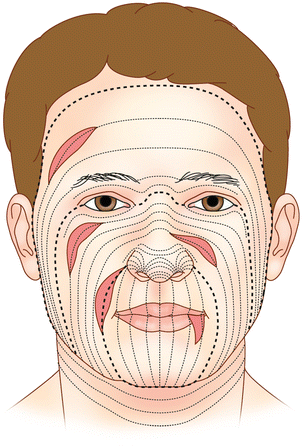Fig. 10.1
Major aesthetic facial subunits. The six major subunits of the face includes (a) the forehead, (b) eyes and eyebrows, (c) nose, (d) cheek, (e) lips, and (f) chin
The preoperative evaluation additionally provides valuable details regarding patient-related variables that may affect the successful repair of a facial defect. Patient comorbidities, for example, is an important consideration for choosing the most appropriate options for wound repair. Patients who have significant comorbidities may benefit from a simple reconstructive effort, even though this technique may result in a less desirable cosmetic outcome. For patients who are active smokers, smoking cessation can be encouraged preoperatively in order to promote improved wound healing following facial reconstruction. Most importantly, at the preoperative evaluation, surgeons should have an open discussion with patients about specific expectations with the facial reconstruction. This preoperative discussion, combined with characteristics of the facial defect and surrounding soft tissue, allows surgeons to formulate an individualized surgical plan that is not only feasible and acceptable from a surgical perspective, but also compatible with patient priorities and desires.
Facial defect closures may occur in either the outpatient setting or the operative suite, depending on the extent of facial soft tissue resection, complexity of reconstruction, patient comorbidities, and the preferences of surgeons and patients. The use of local anesthesia, intravenous sedation, or general anesthesia also varies according to the specific patient-related factors and surgeon preferences. The use of local anesthesia or intravenous sedation offers certain advantages in medically complex patients, including decreased postoperative recovery time and overall operative cost. On the other hand, healthy patients and their surgeons may opt for the use of general anesthesia if there are concerns for airway monitoring, if the planned facial reconstruction is complex and complicated, and if patients anticipate significant anxiety during the procedure.
Operative Strategy
The reconstructive ladder is used to conceptualize the variety of options used to close facial defects as a continuum of increasing levels of complexity (Fig. 10.2). These options range from closure by secondary intent, which is the simplest of techniques in the reconstructive ladder, to a microvascular free flap, which sits at the highest rung of complexity in the reconstructive ladder. Consideration of reconstructive options for cutaneous facial defects generally start with the simplest options, but move up the reconstructive ladder as needed in order to achieve a functionally and cosmetically adequate outcome for patients. Along this gradient of options, the use of linear primary closures on the face is oftentimes a sufficient and reliable technique for most soft tissue defects encountered by surgeons.


Fig. 10.2
The reconstructive ladder. The basis for reconstructive efforts of soft tissue defects is conceptualized on a continuum that places techniques along a range of complexities
The merits of primary closures with bilateral advancement flaps are reflected in the ability of surgeons to repair soft tissue defects using simple primary wound closures while attaining adequate and cosmetically acceptable results. By closing wounds primarily, surgeons are more likely to maximally preserve healthy tissue and effectively match skin texture, color, and thickness. Primary wound closure also avoids the risks that are associated with more advanced reconstructive techniques, including wound contracture with skin grafts and tissue necrosis due to compromised vasculature with local flaps. While other advanced reconstructive techniques may be indicated in facial soft tissue defects that are extensive in size and involve more complex facial aesthetic subunits, these cases are more commonly executed with the consultation of a facial plastic surgeon. Other reconstructive techniques, specifically flap repair, are discussed extensively within the literature.
As is the case for all rungs of the reconstructive ladder, the successful execution of a plan to repair a facial defect with primary closure is based upon general principles of aesthetic reconstruction. First, soft tissue should be handled delicately to reduce excessive trauma and crush injury. Second, a primary wound closure should be completed with the eversion of skin edges and minimizing of wound tension. Wound tension increases the risk for wound dehiscence and widening scarring, and may be reduced through undermining of skin flaps adjacent to the wound and through a layered closure of the soft tissue defects. Third, closure of soft tissue defects along the relaxed skin tension lines most effectively hide scars from the facial repairs. Incision lines at the boundaries of the facial aesthetic subunits are also effectively camouflaged by the light reflections and shadows of facial contours at these locations (Fig. 10.3).


Fig. 10.3
Relaxed skin tension lines (RSTL) of the face. Repairs are best hidden by aligning incisions with the RSTLs of the face
Operative Technique
Soft tissue defects of the face may be repaired sequentially after excision of cutaneous lesions or several days after the excision. In either case, the wound should be thoroughly cleaned prior to the reconstruction. Wound preparation includes removing contaminants and bacteria within the wound through the use of mild disinfectants. Once the wound has been appropriately prepped, areas of nonviable tissue should be debrided to optimize wound healing and to prevent infectious complications.
Stay updated, free articles. Join our Telegram channel

Full access? Get Clinical Tree








